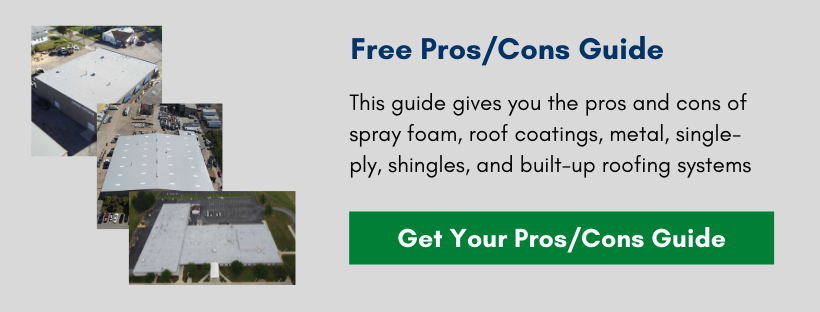With today’s economy, property owners and managers face the daunting task of keeping their facilities running safely and in decent shape. One of the most critical systems in a commercial facility is the roofing system. So, why jump into an investment without knowing the advantages and disadvantages of single-ply membrane roofing?
While the choice is ultimately up to the building owner, we want to point out a few pros and cons to Single-Ply Membrane Roofing Systems.
At the end of the article, we’ll discuss two ways to restore your single-ply roof with a roof coating system or with spray polyurethane foam.
The Basics
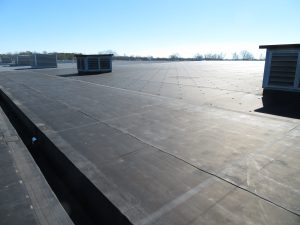
Single-Ply Membranes are sheets of rubber and other synthetics that can be ballasted or chemically adhered to insulation to create a layer of protection for your commercial facility.
Two main single-ply membrane commercial roofing types are Thermoplastic Polyolefin (TPO) and Ethylene Propylene Diene Terpolymer (EPDM). They differ in their chemical makeup, how they are installed, and their energy efficiencies.
Pros of Single-Ply Membrane Roofing
Proven Track Record
EPDM roofing has been used for commercial flat roofing for over 60 years. This time on the market has allowed various laboratory and field studies to be performed and tracked. That’s why single-ply membrane roofing has a proven track record for being a high-performance roofing option.
While having more market share than EPDM, TPO has not been on the market as long as EPDM. This means that TPO single-ply membrane roofing is still under testing and evolving into a more reliable roofing membrane.
Options for Insulation Materials
Single-ply roofing does not include the insulation factor. As a customer, you have more options to insulate your facility’s roof. There are a few types of insulation options the facility manager/owner can choose from:
- Polyisocyanurate (Polyiso) – The most used insulation type for roofing applications, Polyiso is more expensive but pays off with a higher R-value rating.
- Expanded Polystyrene (EPS) – With the highest R-value per dollar, EPS is used for roof, wall, and floor insulation. EPS can be used for ground contact and does not retain water over time.
- Extruded Polystyrene (XPS) – Usually defined by the blue, green, or pink color, XPS falls between Polyiso and EPS in the price range and performance range. XPS is semipermeable with a perm rating of 1.
Choice of Reflective or Retentive Properties
TPO is fast growing in popularity across the commercial roofing market. Also known as “White Roofs,” TPO is generally manufactured white and highly reflective. TPO is available in tan, gray, green, blue, and red.
On the other side of the spectrum, EPDM is often described as “Black Roofs” due to the naturally dark color of the membrane. This high-performance rubber compound provides excellent weather-ability and heat retention beneficial for facilities located in climates with lower “cooling days.”
Easy Installation
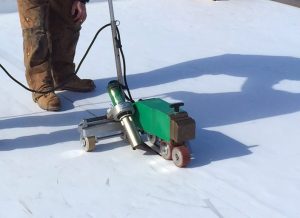
Unlike the complexities of processing spray polyurethane foam roofing, installing single-ply membrane roofing is relatively simple.
After the existing substrate is prepared, either by cleaning or removing the existing roof, the insulation layers are installed and covered by a cover board.
There are three ways to attach the membrane to the cover board: ballasted, with an adhesive, or mechanically fastened.
The significant difference between TPO and EPDM comes when it is time to adhere the membrane seams together. TPO uses a hot-air gun to melt down the membrane at the seams and fuse them together. EPDM is joined together with seam tape.
Lightweight and Flexible
Even though there are multiple layers, you can choose the thickness of the membrane installed on your roof. Overall single-ply membrane roofing is lightweight compared to other commercial flat roof systems. This relieves stress that’s put on your building’s structure. (Excluding ballasted systems)
The flexibility of the single-ply membranes allows the contractor to accommodate unique roof designs. This flexibility also allows the roofing systems to stay intact with expanding and contracting buildings.
Cons of Single-Ply Membrane Roofing
The membrane is Easily Punctured
While we explained in the paragraph above that single-ply membrane roofing is lightweight and flexible, that leads us to our first con, the thin layers are easily punctured.
Single-ply membrane roofing does not have a hard-top layer to protect the synthetic rubber from dropped tools, gravel, or loose screws from being pushed into the rubber membrane. This damage could create holes in the rubber and insulation and be vulnerable to leaks.
Roofing Accessories
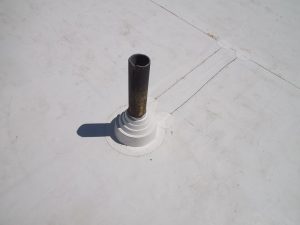
Most commercial roofing systems have accessories such as A/C units, skylights, air vents, plumbing vents, and more. These penetrations on the roof can be in the way of rolling out a straight section of the membrane.
When the contractor approaches these penetrations with single-ply membrane roofing, they need to cut smaller membrane pieces to size. They essentially build up the roof around the vents/units, which takes up more time and is not as reliable in terms of being waterproof.
Seams are Vulnerable to Leaks
We covered in the installation explanation how the rubber membrane is rolled out, overlapped, and fastened with either heat, mechanical fasteners, adhesives, or tapes. Although these seams are sealed, they are more vulnerable to leaks than other roofing systems.
UV Rays
UV rays on the roof can degrade the adhesives quickly over time. This is what can make those seams vulnerable to leaks. Suppose there’s a puncture, tear, or other damage to the roof. In that case, the UV rays coming into the adhesive layer can cause more damage with the adhesives deteriorating.
How to restore your single-ply roof?
If your single-ply roof is at the end of its life, you may think the only option you have is to rip it all off and install another single-ply membrane.
This is false.
A popular option is to install a roof coating system over your existing single-ply roof.
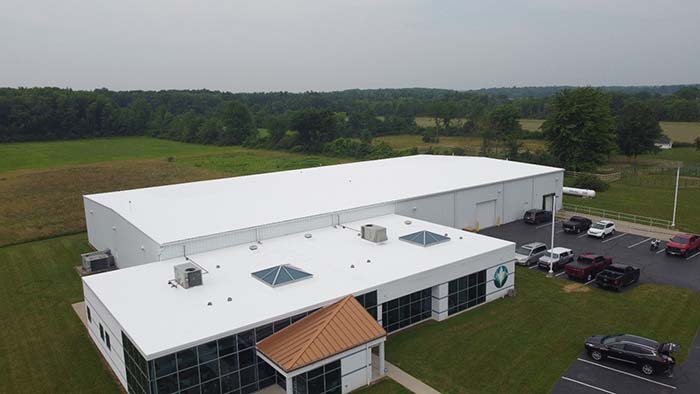
These coatings are very similar to paint, but obviously, they’re very thick and engineered to withstand the harshest weather conditions.
There are some eligibility issues, but if your roof is eligible, a contractor will clean the roof, reinforce the seams, and then add coating over your roof.
Most roof coating systems will give you a brand new 10, 15, or 20-year warranty!
The best part of coating systems is that tear-off is minimized, saving you money.
The second option is to install a spray foam roofing system.

Suppose your single-ply roof is the only roofing system installed. In that case, you can minimize tear-off and install spray foam over what you already have.
The benefits of spray foam include the following:
- a significant increase in R-value (SPF has an R-value of 6.5 per inch of thickness)
- the roof is renewable
- the roof is seamless
In some cases, depending on the current conditions of the roofing systems, you can reduce your energy costs enough to cover the costs of installing the systems.
Essentially, the spray foam roof can pay for itself over 5-10 years.
Conclusion
Single-Ply Roofing Systems take up over half of the roofing systems for commercial, industrial, and manufacturing facilities looking for a sustainable, economically efficient option.
